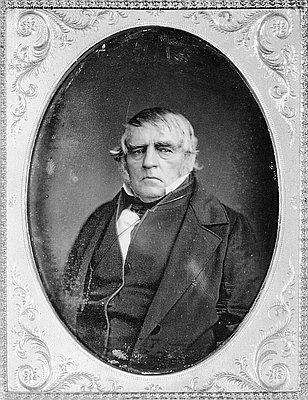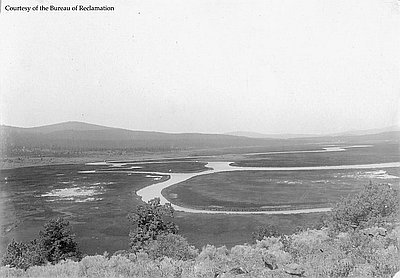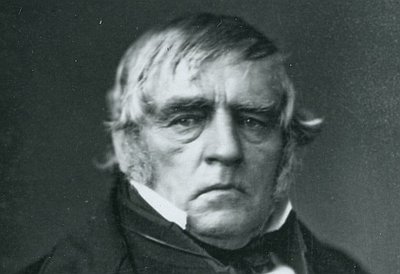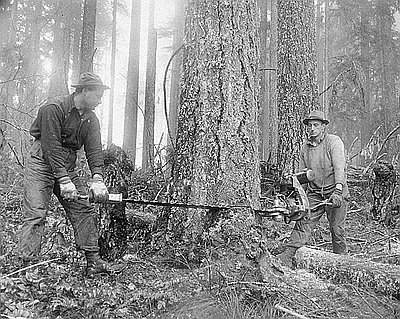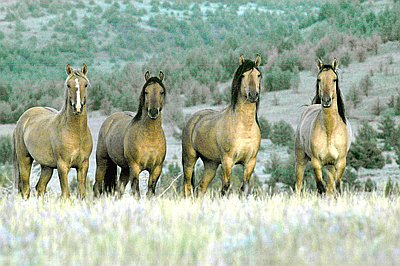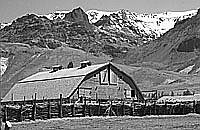Desert Cultures
Settling into southeastern Oregon, Native people developed a way of life that adapted to the resources the land offered them. Termed the Desert Culture by archaeologists, the people of the northern Great Basin and the Snake River Plain relied on focused hunting and intensive gathering for survival. Herds of migratory buffalo, for example, ranged through southeastern Oregon, and a few archaeological sites indicate that bison hunting occurred as recently as the early nineteenth century. People of the Desert Culture relied on the more plentiful bighorn, deer, and other local game for protein. Periodic jackrabbit drives involved several, usually distant, groups who worked together. Using strategically placed net fences to trap the rabbits, a few dozen men, women, and children could snare thousands of the animals, which they used for food and also skinned for winter blankets, warm clothing, and strong cordage. In the Malheur and Owyhee river drainages, relatively small quantities of spawning salmon supplemented their diet. Native women gleaned large quantities of a wide assortment of edible seeds, roots, and bulbs, providing the majority of their families’ food.
People who lived the region were organized into autonomous groups, or bands, each of which typically included a few extended families. Each group inhabited and relied on the resources of a fairly large home territory. After spending winter in a village of pole-and-thatch huts, typically located along a lower-elevation river or lakeshore, a band typically broke up into smaller groups during the spring. Through summer and into fall, they followed the movement of game animals, as well as the seasonal succession of plant harvests, into the forested mountains before returning to the warmer valleys for the winter.
People of the Desert Culture may have valued group harmony and, unlike some Native groups elsewhere in the Pacific Northwest, they apparently did not put much emphasis on social status or individual wealth. Religious beliefs and practices centered on the powerful spirits that inhabited the world around them, particularly certain animals and places. The job of the shaman, or puhagami—Northern Paiute for “power person,” a group’s religious specialist—was to mediate with the spirit world. He or she often accomplished this by means of extended trances and altered states of consciousness. Many of the symbols found in the region’s ancient petroglyphs and pictographs likely attest to the spirit quests of shamans.
The evidence suggests that groups ancestral to the Klamath-Modoc people once inhabited much of southeastern Oregon. It may have been these people who, about 2,000 years ago, built large pithouse villages along the shores of Abert Lake, villages that were occupied at a time when that now-saline lake supported freshwater fish. Over time, as Abert and other lakes of the region became brackish ponds where only tiny brine shrimp can survive, these people may have pulled back to the west, where deeper lakes and abundant rivers enabled a culture built on fishing to flourish.
Although the Klamath-Modoc continued to use the western fringes of southeastern Oregon, a new group of Desert Culture people came on the scene about 1,500 years ago. Over the course of several centuries, anthropologists believe, these people spread northward from their original homeland in the southwestern Great Basin. Known today as the Northern Paiute, they arrived well adapted to the arid conditions found in southeastern Oregon. Their close linguistic cousins, the Northern Shoshone and the Bannock, settled to the east, in parts of the Owyhee Uplands and most of Idaho’s Snake River Plain.
Each Northern Paiute subgroup occupied a fairly well-defined homeland, or tebiwa. The name of each group derived from some characteristic food that they ate. The people who lived in the Harney Basin called themselves Wadatika, or “wada-eaters” to differentiate themselves from their Northern Paiute neighbors. The presence at archaeological sites of goods such as olivella shells from the California coast indicates that Northern Paiute and their predecessors engaged in long-distance trade. Later, lightweight but high-value items such as brass buttons, glass beads, and other European and American trade goods trickled into the region from the Northwest Coast or from across the Rocky Mountains. The By the mid 1700s, the Nez Perce to the north had become a horse-mounted buffalo-hunting people, but the Northern Paiute apparently did not begin to keep horses until nearly a hundred years later, perhaps in part because bison no longer lived close to the high desert.
In the early nineteenth century, Hudson’s Bay Company fur trader Peter Skene Ogden remarked with incredulity on the comparatively large number of people he encountered while traveling through the marsh-studded Warner Valley. Beginning with Ogden’s brief forays into the region, however, southeastern Oregon’s Native population soon faced an onslaught of new arrivals, people who had a dramatically different culture and outlook.
© Jeff LaLande, 2005. Updated and revised by OE staff, 2014.
Sections
Related Historical Records
Family of Bannock Indians, 1872
This photograph shows a family of Indians, identified by the photographer as Bannocks, sitting in front of a small pole-and-thatch lodge. It was taken in Idaho Territory in …
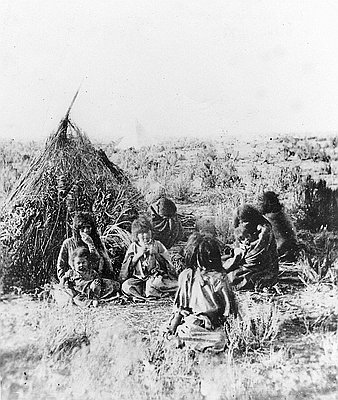
Shoshone Fish Weir
This excerpt from Meriwether Lewis’s journal describes a Lemhi Shoshone fish weir on present-day Idaho’s Lemhi River, a tributary of the Salmon River. After months of travel the Corps of …
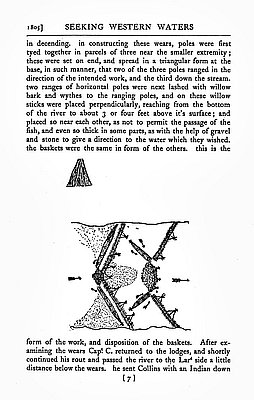
Peter Skene Ogden (c. 1790-1854)
Peter Skene Ogden was a key figure in the land-based fur trade of the Pacific Northwest and British Columbia during the first half of the nineteenth century. This photograph …
